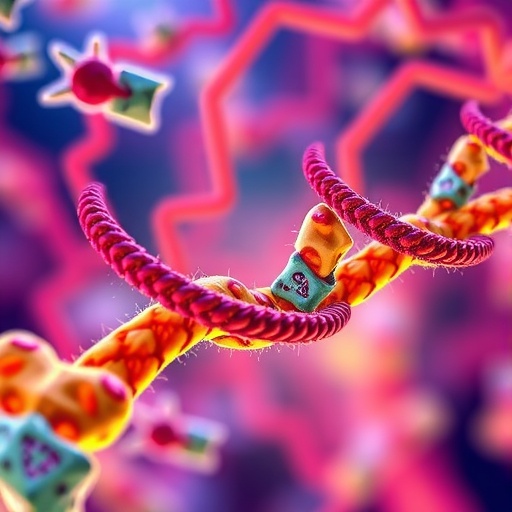In a revolutionary advancement that challenges one of the most fundamental tenets of evolutionary biology, an international team of researchers has uncovered compelling evidence that genetic mutations—long assumed to be purely random occurrences—may instead arise in a targeted manner where their adaptive value is greatest. Published in the prestigious Proceedings of the National Academy of Sciences (PNAS), this new study illuminates the possibility that the mutation rates of specific genes are not uniform across populations or genomic loci but are influenced by evolutionary necessity and prior genetic context.
The team, led by Prof. Adi Livnat of the University of Haifa and Dr. Daniel Melamed, utilized cutting-edge ultra-accurate mutation detection techniques to scrutinize the de novo emergence of mutations within the human APOL1 gene. This gene is critically significant because certain variants confer resistance against trypanosomiasis, a devastating parasitic disease endemic to sub-Saharan Africa. Notably, carriers of the APOL1 mutation face a trade-off, as possessing two copies of the variant increases susceptibility to chronic kidney disease—a classic case of evolutionary balancing selection.
Traditionally, evolutionary theory has been predicated on the assumption that mutations occur randomly with respect to their utility. These stochastic alterations serve as raw material for natural selection, which sculpts populations by favoring advantageous changes and purging deleterious ones. Direct empirical evidence validating this randomness, however, has been elusive due to the scarcity of mutation events in the vastness of genomic DNA and the technical challenges of detecting them as they naturally arise.
By pioneering a novel, highly sensitive mutation detection system, Livnat and colleagues previously demonstrated that the HbS mutation in the hemoglobin beta gene, which provides malaria resistance yet causes sickle-cell disease in homozygotes, does not manifest randomly. Instead, it emerges more frequently in populations and genomic regions where it confers concrete survival advantage. Building upon these findings, the current study reveals that the APOL1 mutation follows this same nonrandom pattern, arising disproportionately in sub-Saharan African populations under intense trypanosomal selective pressure, but scarcely in European populations lacking such exposure.
These results destabilize the entrenched concept of mutation randomness and suggest an additional, internal evolutionary force actively shapes mutational landscapes. According to Livnat’s new theoretical framework, evolution is driven by a synergy between two forces: the familiar external impetus of natural selection, which operates on phenotypic fitness, and a previously underappreciated internal force that orchestrates the genetic variation itself. This internal force, termed “natural simplification,” involves the genome’s intrinsic capacity to reorganize information, streamlining and hardwiring biological interactions that develop over evolutionary time.
A compelling example arises with gene fusion mutations. Previously regarded as accidental chromosomal rearrangements occurring sporadically, new evidence indicates that fusion events preferentially involve genes that function together and interact routinely within cellular networks. Mechanistically, the three-dimensional folding of chromatin in the nucleus spatially congregates these functionally allied genes, rendering their fusion via molecular processes more feasible. The evolutionary consequence is simplification of regulatory complexity, embedding coordinated gene interactions directly into the genome’s architecture.
The PNAS paper extrapolates this phenomenon to suggest that similar internal drivers underlie diverse mutational mechanisms, from point mutations to transposable element insertions. Each mutation’s emergence is influenced by an evolving genomic context, with early mutations setting the stage for subsequent changes in a cumulative and interconnected manner. This dynamic engenders mutations that are neither arbitrary nor discrete, but meaningfully tied to regulatory networks and environmental pressures over long timescales.
Livnat elaborates that in contrast to the traditional averaging of mutation rates across extensive genomic regions—which obscures nuanced differences—the probability of individual mutations varies significantly. The mutational propensities are molded by the history of genetic interactions up to that generation, effectively embedding adaptive responses into the genome’s mutable code. This convergence of internal mutation biases and external selection pressures leads to an emergent trend wherein populations under specific environmental challenges display targeted mutational responses, as seen in malaria-protective HbS and Trypanosoma-resistant APOL1 variants.
At the core of this paradigm shift is the concept that genetic novelty does not arise from blind accidents but through the simplification of complex biological regulation into modular, co-optable genetic elements. These elements, shaped by accumulated evolutionary information and performance pressures, serve as building blocks for innovation at the systemic level rather than at the isolated point mutation scale. Under this lens, mutations embody meaningful evolutionary processes, emerging as integrated units optimized to address specific adaptive challenges.
This reframing holds profound implications not only for evolutionary biology but also for medicine, where understanding mutation origination can illuminate disease predispositions and aid in developing targeted therapies. Furthermore, insights gleaned from these principles may inform computational sciences—particularly in evolutionary algorithms and artificial intelligence—by encouraging models that incorporate directed mutation and internal information processing rather than purely stochastic variation.
Analogies between genomic evolution and cognitive processes further extend the scope of this framework. For instance, gene fusion mirrors the cognitive chunking mechanism in the brain, where frequently co-occurring pieces of information are merged into cohesive units to improve efficiency and learning. Such parallels suggest that fundamental principles of information processing and simplification govern both genetic evolution and neural function, highlighting an intriguing unity between biological scales.
This groundbreaking work, funded by the John Templeton Foundation, the Israel Science Foundation, and the Sagol Network, opens new avenues of research into mutation mechanisms. By unveiling an internal evolutionary force that complements natural selection, it challenges long-held assumptions and invites a reevaluation of how genomic variation and biological innovation truly arise. As methods continue to evolve and more genomic data become available, further exploration of this internal mutation paradigm promises to deepen our understanding of life’s complexity and evolutionary dynamics.
Subject of Research: De novo mutation rates of Trypanosoma-resistant mutations in human populations
Article Title: De novo rates of a Trypanosoma-resistant mutation in two human populations
News Publication Date: 25-Aug-2025
Web References: 10.1073/pnas.2424538122
Keywords: Evolutionary biology, nonrandom mutation, genetic mutation rates, APOL1 gene, Trypanosomiasis resistance, gene fusion, natural simplification, mutation origination, evolutionary genetics, balancing selection




